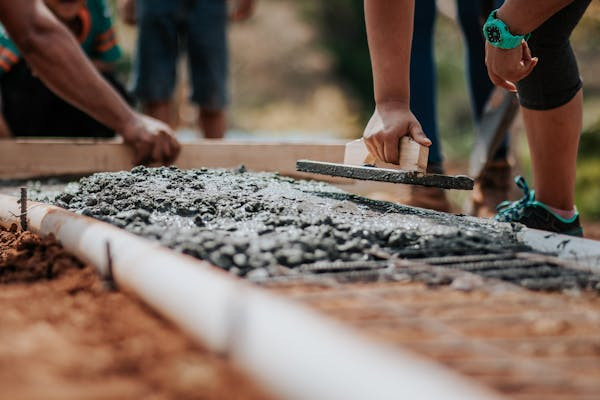Unveiling the Beauty and Versatility of Concrete: A Comprehensive Guide

Concrete, often associated with industrial settings and utilitarian purposes, is undergoing a renaissance in the world of design and construction. From sleek modern interiors to rustic outdoor spaces, concrete has emerged as a versatile and stylish material that offers both beauty and functionality. In this comprehensive guide, we'll delve into the myriad uses, benefits, and design possibilities of concrete, showcasing its potential to elevate any space.
1. The Many Faces of Concrete
Contrary to popular belief, concrete is far from one-dimensional. In its raw form, concrete exudes an understated elegance with its smooth, minimalist surface. However, it can also be transformed through various techniques and finishes to achieve a wide range of aesthetics.
-
Polished Concrete: Polishing concrete enhances its natural beauty while creating a glossy, reflective surface that adds sophistication to any space. Ideal for both residential and commercial applications, polished concrete is durable, easy to maintain, and offers limitless design possibilities.
-
Stamped Concrete: Stamped concrete replicates the look of natural materials such as stone, brick, or wood, allowing for the creation of custom patterns and textures. Perfect for outdoor patios, walkways, and driveways, stamped concrete combines the beauty of natural materials with the durability of concrete, providing a cost-effective alternative to traditional paving materials.
-
Colored Concrete: Through the use of pigments and dyes, concrete can be infused with vibrant colors to complement any design scheme. Whether you prefer subtle earth tones or bold hues, colored concrete allows for endless creative expression, making it an ideal choice for interior floors, countertops, and decorative elements.
2. The Advantages of Concrete
Beyond its aesthetic appeal, concrete offers a multitude of practical benefits that make it a preferred choice for architects, designers, and homeowners alike.
-
Durability: Concrete is renowned for its strength and durability, making it suitable for high-traffic areas and outdoor spaces subjected to harsh weather conditions. Unlike other materials that may warp, fade, or degrade over time, concrete maintains its integrity and appearance for decades with minimal maintenance.
-
Versatility: From sleek modern interiors to rustic outdoor retreats, concrete adapts to any style and setting with ease. Its versatility allows for seamless integration into a variety of design schemes, whether used as flooring, countertops, walls, or architectural elements.
-
Sustainability: As a locally sourced, recyclable material, concrete is inherently sustainable and environmentally friendly. Its longevity and low maintenance requirements further reduce its environmental impact, making it a sustainable choice for eco-conscious projects.
3. Designing with Concrete
When incorporating concrete into your design projects, consider the following tips to maximize its potential and achieve stunning results:
-
Texture and Contrast: Experiment with different textures and finishes to add visual interest and contrast to your concrete surfaces. Combining polished and rough textures, or mixing colored and natural concrete, creates dynamic visual effects that enhance the overall aesthetic of your space.
-
Integration with Other Materials: Concrete pairs beautifully with a wide range of materials, including wood, glass, and metal. By integrating complementary materials, you can create depth and dimension in your design while highlighting the unique qualities of concrete.
-
Customization and Personalization: Take advantage of concrete's versatility to create custom designs and features that reflect your personal style and preferences. Whether it's embedding decorative aggregates, incorporating intricate patterns, or adding personalized touches, concrete allows for endless customization options.
4. Maintaining Concrete Surfaces
While concrete is inherently low maintenance, proper care and maintenance are essential to preserve its beauty and longevity. Follow these tips to keep your concrete surfaces looking their best:
-
Regular Cleaning: Sweep or vacuum concrete floors regularly to remove dirt and debris, and mop with a mild detergent as needed to remove stains and spills.
-
Sealing: Apply a quality sealer to protect concrete surfaces from stains, moisture, and UV damage. Reapply sealer periodically according to manufacturer's recommendations to maintain optimal protection.
-
Avoid Harsh Chemicals: Use caution when cleaning concrete surfaces and avoid harsh chemicals that can damage the sealer or discolor the concrete. Opt for pH-neutral cleaners and avoid abrasive cleaning tools that may scratch or dull the surface.
5. Finding Expertise with Concrete Professionals
When embarking on concrete projects, seeking the expertise of professionals is paramount to ensure quality results and project success. Websites like 'concretersbrisbane.com' offer a platform to connect with experienced concrete contractors who possess the skills and knowledge necessary to bring your vision to life. From initial consultation to project completion, partnering with reputable concrete professionals ensures that your project is executed with precision and attention to detail, delivering lasting value and satisfaction.
In conclusion, concrete is not merely a building material but a design statement that embodies beauty, durability, and versatility. Whether used indoors or outdoors, polished or textured, colored or natural, concrete offers endless possibilities for creative expression and architectural innovation. By understanding its potential and incorporating it thoughtfully into your design projects, you can unlock the transformative power of concrete and create spaces that inspire and endure.
